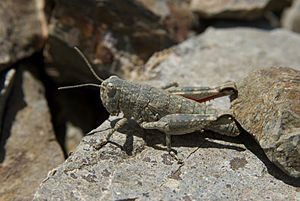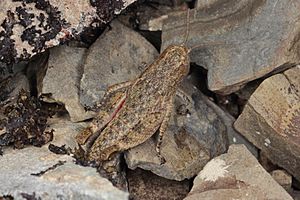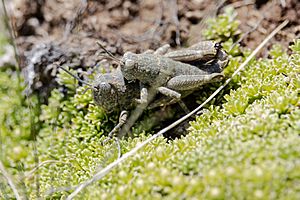Brachaspis nivalis facts for kids
Quick facts for kids Brachaspis nivalis |
|
|---|---|
 |
|
| Conservation status | |
| Scientific classification | |
| Genus: |
Brachaspis
|
| Species: |
nivalis
|
| Synonyms | |
|
|
The Brachaspis nivalis is a special type of grasshopper found only in the mountains of New Zealand's South Island. It's often called an alpine short-horned grasshopper. These grasshoppers can't fly because their wings are too small, so they get around by hopping. They love to warm up in the sun during the day, which is why they live in open, sunny places.
Contents
About the Brachaspis nivalis
Scientists first learned about the Brachaspis nivalis grasshopper in 1897. A scientist named Captain Frederick Wollaston Hutton found them near Mount Cook and in the Marlborough area. At first, he put them in a different group of grasshoppers. But in 1898, Hutton created a new group, or genus, just for them, called Brachaspis. This name means "short and broad shield," which describes a part of their body. Later, in 1967, another scientist named Bigelow helped define this group better.
There are other similar grasshoppers in the Brachaspis group, like Brachaspis collinus and Brachaspis robustus. The B. nivalis grasshopper is found in places like Canterbury and Kaikoura. Even though they might sometimes breed with B. collinus in certain areas, scientists still consider them different species.
Where They Live
Brachaspis nivalis grasshoppers are very common in rocky mountain areas. They like places with scattered plants, not thick grass like some other grasshoppers. You can find them high up in the mountains, from about 600 meters to 2000 meters (that's about 2,000 to 6,500 feet) above sea level. They are found all over the high parts of New Zealand's South Island, including Marlborough, Canterbury, and northern Otago.
What They Look Like
Brachaspis nivalis grasshoppers are amazing at blending in with their surroundings. They have colors that match the rocks and ground where they live. They can be grey or a mix of grey and mottled brown. Some even have bright flashes of scarlet, purple, or indigo-black on their back legs! This is different from another type, B. collinus, which has reddish-brown back legs.
Male B. nivalis grasshoppers are usually smaller than females. Males are about 15-24 mm long, while females can be 16-40 mm long. Their back legs, which they use for hopping, are also different sizes: 8.5-12.5 mm for males and 11.5-17 mm for females. Generally, these grasshoppers are smaller than the B. robustus species. Interestingly, the higher up in the mountains they live, the bigger they tend to be. The largest ones are found above 1200 meters.
What They Eat
Brachaspis nivalis grasshoppers are herbivores, meaning they eat plants. They are not picky eaters and will try many different plants. They especially like to eat the flowers of plants. Some of the plants they have been seen eating include Hebe, Epilobium, Celmisia, Poa, Wahlenbergia albomarginata, Anisotome aromatica, Chionochloa pallens, Coprosma pumila, and Pittosporum crassicaule. They also eat ferns like Austroblechnum penna-marina, mosses like Polytrichum juniperinum, and even lichens. Sometimes, they might accidentally eat small insects, but this isn't their main food.
Their Life Cycle
Like many insects, Brachaspis nivalis grasshoppers go through different stages as they grow. Males usually go through six stages, called instars, before they become adults. Females go through seven instars. The youngest grasshoppers are often seen in January and February.
Adult B. nivalis grasshoppers can mate throughout their adult lives. Males can live for about 21.8 months, and females can live a bit longer, up to 26.1 months.
Reproduction
These grasshoppers mate with different partners each time. When a male tries to mate, he often climbs onto the female, even if she tries to resist. He holds on tightly to make sure they aren't separated. Mating pairs have been seen from spring to autumn (September to April).
Female grasshoppers lay eggs multiple times. They lay their eggs in groups called "egg pods," and each pod can have 20-30 eggs. The first young grasshoppers hatch in late December or early January.
Conservation Status
The Brachaspis nivalis grasshopper is currently considered "Not Threatened" by the NZTCS. This status has been the same since 2010. However, scientists are still studying them. If it turns out that some of the smaller grasshoppers living at lower elevations are a unique group, their conservation status might need to be re-evaluated. These lower-elevation groups could be at risk from things like floods, new buildings, invasive weeds, and animals that hunt them.
Also, the number of B. nivalis grasshoppers depends on the temperature of the soil. This means that if the Earth's temperature keeps getting warmer due to climate change, these grasshoppers might lose the cool mountain habitats they need to survive in the future.




